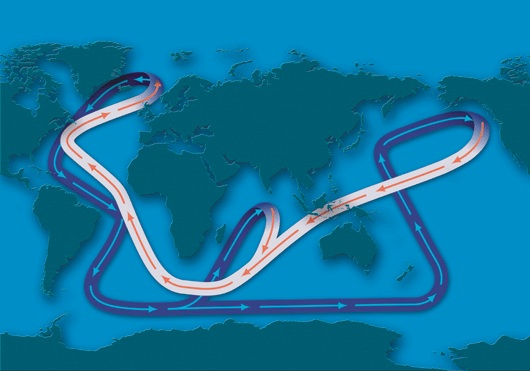Despite Warnings, Ocean Circulation Not Slowing Down

Scientific evidence and Hollywood's "The Day After Tomorrow" have fueled fears that global warming could disrupt the Atlantic Ocean's main circulation system and drastically alter global weather patterns, but there is no firm evidence that shows this is actually happening, says a prominent oceanographer.
The main ocean circulation system, called the global conveyor belt, helps redistribute heat around the planet. Warm surface water flows poleward from the tropics and cools, becoming denser and eventually sinking when it reaches the North Atlantic. The cooled water then returns along the bottom of the ocean to the tropics.
Scientists worry that because human-induced global warming seems to be increasing temperatures most rapidly at the poles, the air above the water will warm it up, preventing it from sinking and thus slowing down the circulation.
"There's reason that we might expect a slowdown," said Susan Lozier of Duke University, who will present her research in an American Meteorological Society seminar on Wednesday. But she says there is no evidence yet to suggest that it is.
Lozier said there are problems detecting such changes because the ocean is so large and currents are highly variable, and "the ocean is really, really undersampled," so scientists don't have enough data to see long-term trends.
Circulation changes are also more complicated because salinity, or the concentration of salt in the water, also affects its density, while certain changes in salinity and temperature can compensate for each other.
If the conveyor belt were to shut down, it would happen over decades, not days or years, Lozier said.
Get the world’s most fascinating discoveries delivered straight to your inbox.
Lozier will call for more thorough monitoring of the ocean to better detect changes in ocean circulation and its impact on climate.
A shutdown could affect rainfall patterns, because ocean circulation is instrumental in determining global weather. Fellow AMS presenter Richard Seager, of Columbia University, will talk about how droughts in the American West, like the Dust Bowl of the 1930s, are connected to cooler, drier conditions in the Pacific and how models show that these droughts will become more prevalent in the next century.
- Top 10 Surprising Results of Global Warming
- North Atlantic Ocean Temps Hit Record High
- Global Warming Makes Sea Less Salty
- All About Global Warming

Andrea Thompson is an associate editor at Scientific American, where she covers sustainability, energy and the environment. Prior to that, she was a senior writer covering climate science at Climate Central and a reporter and editor at Live Science, where she primarily covered Earth science and the environment. She holds a graduate degree in science health and environmental reporting from New York University, as well as a bachelor of science and and masters of science in atmospheric chemistry from the Georgia Institute of Technology.


